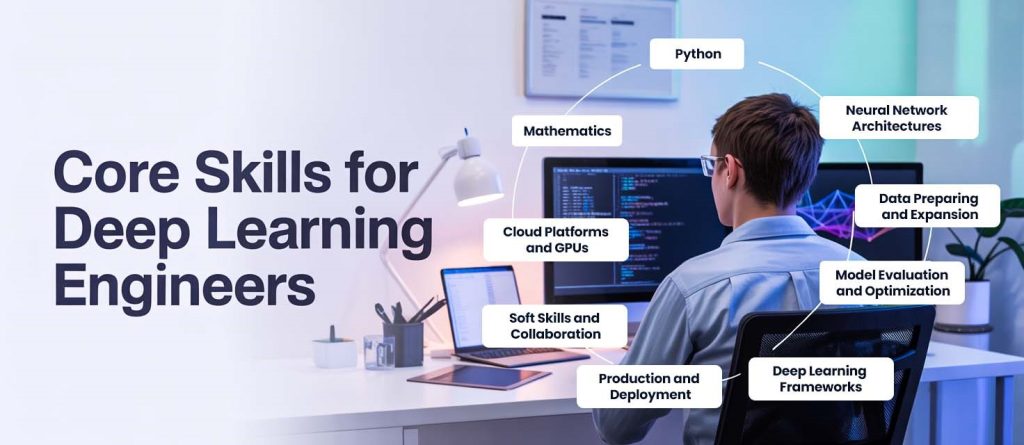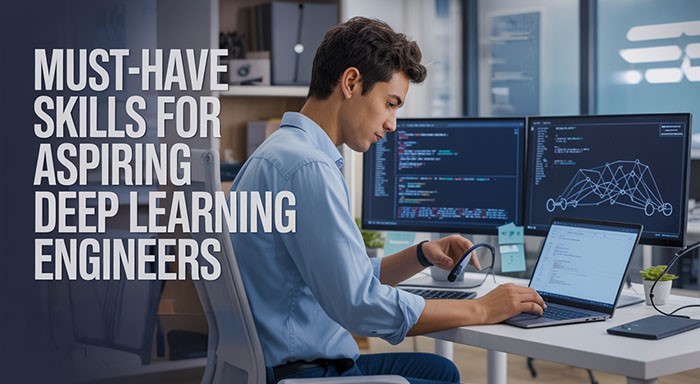Deep learning has quickly become the most exciting technology in the artificial intelligence domain. From self-driving cars and medical diagnostics to recommendation systems and natural language processing, it's reshaping diverse industries. The rapid integration of AI into business operations creates the need for deep
Deep learning has quickly become the most exciting technology in the artificial intelligence domain. From self-driving cars and medical diagnostics to recommendation systems and natural language processing, it's reshaping diverse industries. The rapid integration of AI into business operations creates the need for deep learning engineers. Although successfully implementing this domain is not about curiosity, it requires comprehensive expertise involving theoretical, practical, and technical knowledge. This blog explains what the essential skills are that ambitious deep learning engineers need to attain. Irrespective of whether you are a beginner exploring the domain or a working professional looking for a structured course to upskill.
Introduction
Deep learning engineers typically work with data science, software engineering, and artificial intelligence. The role of these experts is to design, develop, and deploy neural network models that can solve intricate real-world problems. Examples include facial recognition, instant language translation, and driverless vehicles. The ability to process large amounts of chaotic data using multilayered neural networks make deep learning different from traditional machine intelligence. While this compelling feature makes it highly robust, it also adds complexity to technology.
For working professionals, having the basic knowledge of coding is not enough—it requires some advanced skills to successfully move into this space. This includes comprehending model architecture, data processing, deployment pipelines, and optimization methods. This is where enrolling in a comprehensive deep learning course can make a difference, providing practical expertise and demanding industry skills. Let’s discuss the key skills essential for everyone seeking to become a deep learning engineer in the fast-paced world of today.
Core Skills for Deep Learning Engineers

1. Basic Knowledge of Mathematics and Statistics
Deep learning is not about writing code—the model depends greatly on math concepts. Behind every network, the concept includes calculus, probability, linear algebra, and statistics. Having a strong foundation of these principles determines how the model behaves. This includes:
- Improving loss functions
- Creating and elaborating activation function
- Executing gradient descent
- Comprehending model synergy and overfitting
While it does not mean you have to master mathematics, having basic knowledge of these concepts aids you in designing good models and debugging errors more efficiently.
2. Expertise in programming (Mainly Python)
Python is a widely used programming language for deep learning. Professionals need to have proficiency of:
- Crafting clean, well-structured code
- Handy with libraries like Numpy, Pandas, and Matplotlib for data visualization and processing
- Utilizing deep learning frameworks such as Keras, PyTorch, and TensorFlow
Advanced knowledge of tools like Git, CLI (Command-line Interface), and Jupyter Notebooks is necessary for project management and collaboration.
3. Comprehending Neural Network Architectures
A strong understanding of neural network basics is crucial to successfully deploy deep learning models. This includes:
- LSTMs and RNNs (Recurrent Neural Networks) for homogenous data
- Transformer for Large Language Models
- Feedforward Neural Networks (FNNs)
- Convolutional Neural Networks (CNNs) for image related tasks
Knowing the right time and how to use architecture allows engineers to personalize solutions according to the problem and types of data they used.
4. Data Preparing and Expansion
In most cases the data is messy or not ready to use. The quality of data can drastically affect model performance. Data preprocessing ensures the model trains with relevant, high-quality data. Data engineers should know how to:
- Clean, simplify, and reshape datasets
- Manage skewed classes
- Perform data expansion techniques in image and text data
- Leverage pipelines to automate and streamline preprocessing tasks
Data preprocessing is not just a choice; it determines the working, efficiency, and performance of models.
5. Model Evaluation and Optimization
Creating a model is not enough; evaluating and customizing it for greater generalization and preciseness is vital. Here are the best practices:
- Selecting the correct assessment parameters like precision, recall, F1-score, etc.
- Hyperparameter tuning (batch size, number of layers, and learning rate)
- With Cross validation, dropout, and regularization to overlook overfitting
- Use tools to monitor performance like TensorBoard
With a combination of theoretical knowledge and practical analysis, model optimization makes a difference.
6. Expertise with Deep Learning Frameworks
Advanced deep learning model development significantly depends on frameworks. Engineers need to have expertise in:
- Keras – Streamline interface for creating models in TensorFlow.
- TensorFlow – Provide powerful tools for designing and deploying models
- PyTorch – Suitable for research and fast experimentation
These robust frameworks offer ready-made components and adaptable solutions for training and deploying models in live environments.
7. Understanding of Cloud Platforms and GPUs
With deep learning, training a model usually requires extensive computation ability. Developers need to familiar with:
- Cloud platforms like Azure, Google Cloud, and AWS
- GPU utilization and upgradation for quick training
- Google Colab or Kaggle Notebook for free computing resources.
These tools aid in managing massive datasets and thorough architectures effectively.
8. Prepare for Production and Deployment
The ability to launch models into real-work applications is often an ignored element. Here is what it includes:
- Deploying models using TensorFlow Lite and ONNX
- Executing models through APIs using Flask or FastAPI
- Keep track performance after launching the model
- Interconnecting models with existing business operations
Model deployment connects the gap between research and real environmental impact.
9. Soft Skills and Collaboration
Developing a deep learning project is not possible with solo efforts—it often requires team efforts. Meanwhile solid communication, problem-solving, and collaboration skills are crucial, especially for:
- Working with product teams, technical experts, and data engineers
- Model documentation and processes for team use
- Presenting technical results to non-technical stockholders
For becoming a comprehensive engineer, gaining technical knowledge with teamwork and scalability is crucial.
Boost Your Skills through Deep Learning
Due to the complex nature, learning deep learning on your own can be irresistible. A well-organised deep learning online course offers a clear, step-by-step process covering all essential components, from basic math to deployment. This all-encompassing course provides you with hands-on experience through real-world projects, offers industry exposure, and mentorship opportunities from expert professionals. Features like flexible schedules, project-based evaluations, and recorded sessions make it accessible and more effective for working professionals.
Conclusion
From mathematical expertise and programming proficiency to model deployment and optimization, understanding a diverse skill set helps you become a successful deep learning engineer. With the rapid growth of technology, this increases the need for expert engineers who can create robust models and can resolve real-world complex problems easily. Enrolling in a deep learning course that meets the needs of professionals can streamline the learning process. With the well-organized course, you not only learn theoretical insights but also gain hands-on experience required to succeed in AI-enabled industries. Adopting these essential skills helps ambitious deep learning engineers to set themselves a foundation of technological innovation.
Also check
Canva QR Code Generator: A Complete Guide to Creating Stunning QR Codes
MLP G5 AI Voice Models: How to Make My Little Pony Characters Speak Your Words?
Respond to this article with emojis






